Wayfinding at SFO Museum
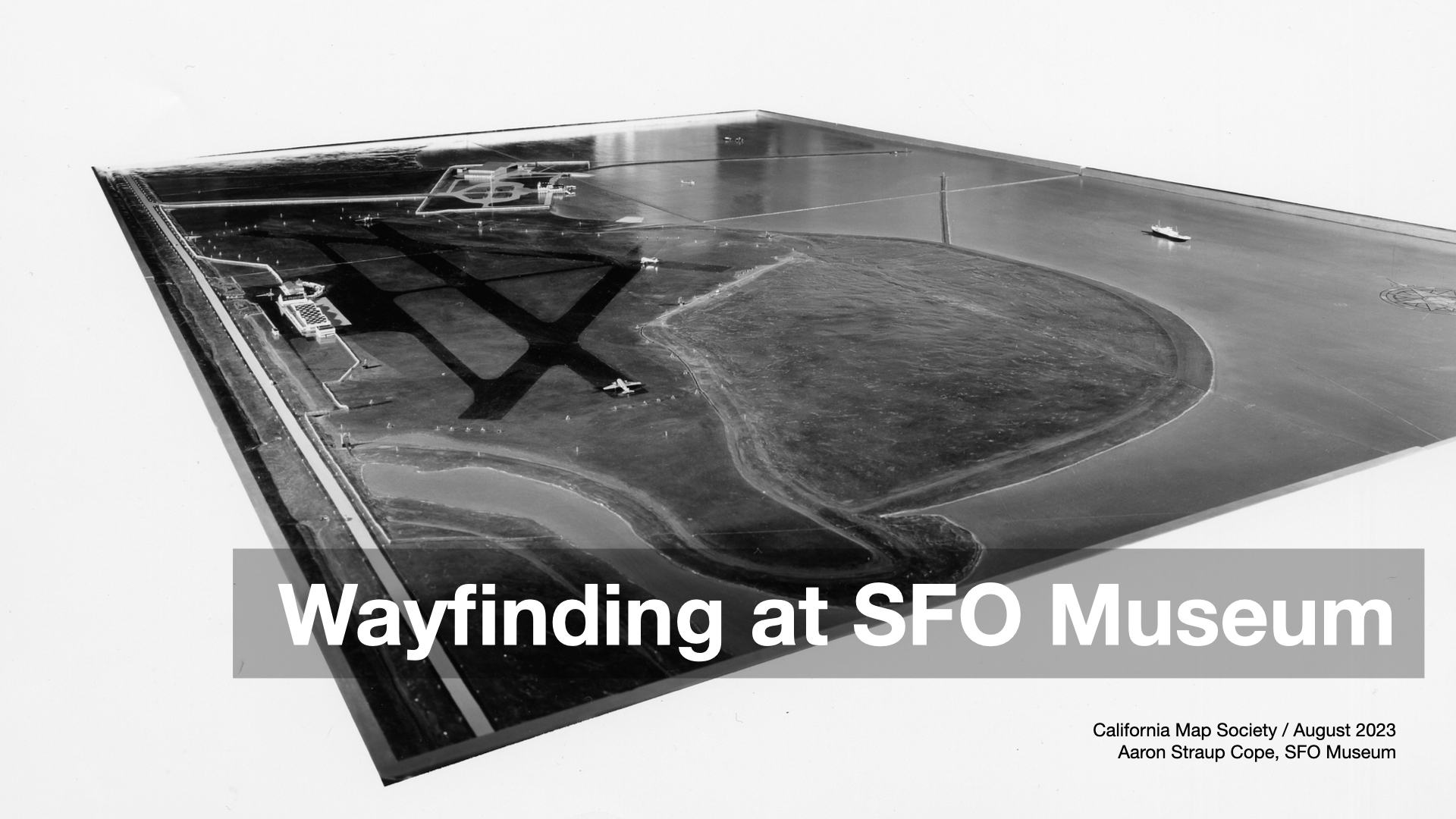
Last weekend I had the opportunity to speak about SFO Museum's Wayfinding system at the 2023 California Map Society Conference, held at the David Rumsey Map Center. Thanks to Tom Paper, who organized the event, for inviting me and allowing me to talk about maps but really to talk about what these particular maps makes possible and what those possibilities say about the museum sector in 2023.
This is what I said.

I'd like to start with a quote from Yoko Ogawa's The Memory Police
:
My memories don't feel as though they've been pulled up by the root. Even if they fade, something remains.
This is a book that wouldn't suffer from being required reading for all Museum Studies students.
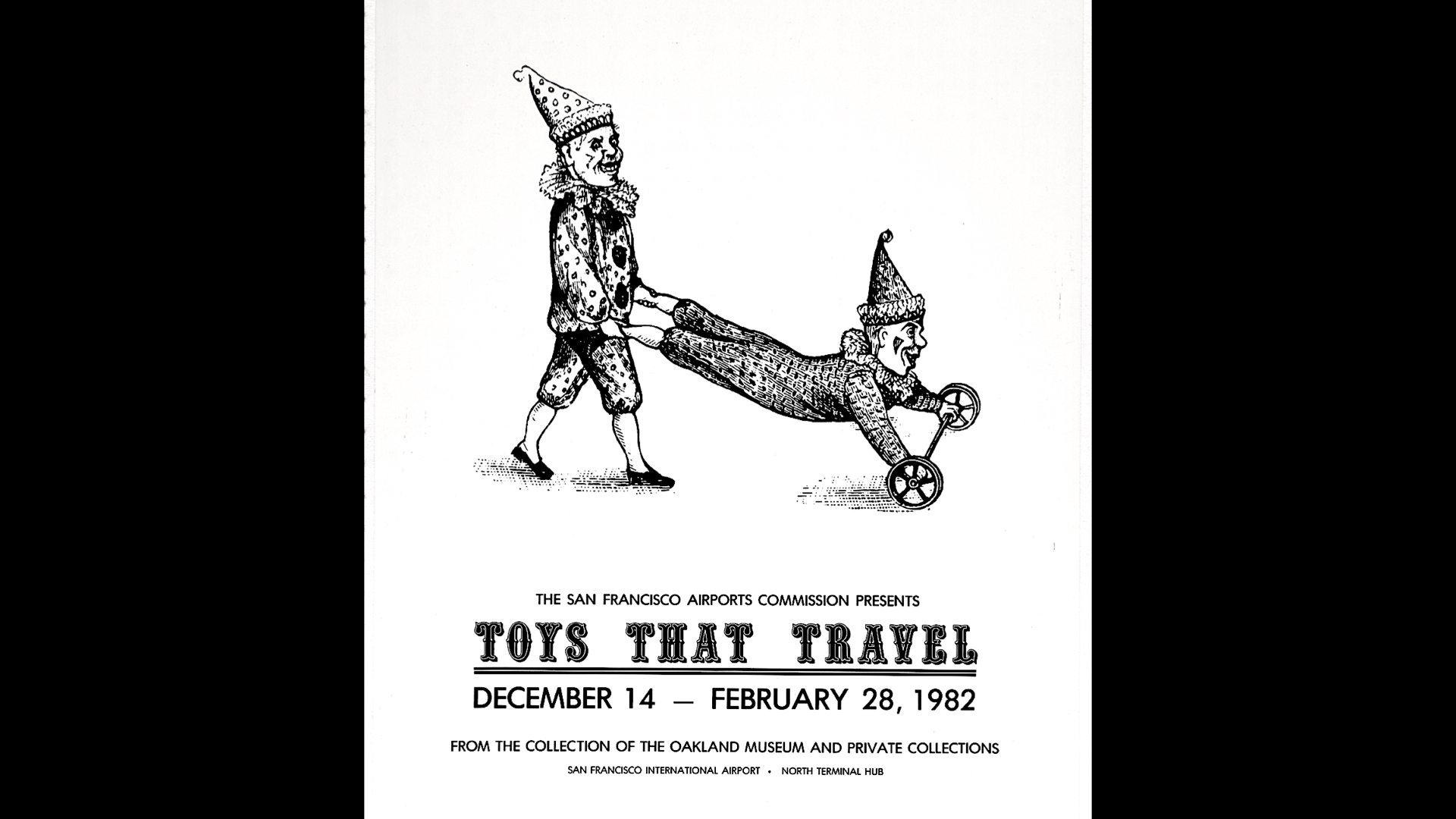
Before the COVID-19 pandemic the San Francisco International Airport, or SFO, handled over 58 million passengers a year and, if the current trends continue, the airport is well on its way to matching and exceeding those numbers in the years to come.
In 1980 the airport started an arts program that would become a fully accredited museum in 1999. In those 43 years the museum has mounted over 1,500 exhibitions in dozens of galleries, stewards over 100 public artworks purchased by the San Francisco Arts Commission and has built a permanent collection of over 150,000 aviation-related objects.
For these reasons I am fond of pointing out that the San Francisco International Airport Museum is the busiest museum in the world... that no one has ever heard of.

This screenshot was taken from the OpenStreetMap website a couple of days ago. It depicts the 3C North Connector
gallery that was opened in 1981 but was removed, three years ago, in 2020. For many people this one gallery is the museum. If it's not this gallery it's usually another specific gallery located in whatever terminal they travel out of most often. The Museum publishes online and printed maps detailing the scale and scope of its holdings but, despite all that, the question those of us who work at the museum are still most often asked is : Where is the museum?
We try to tell people that the whole airport is, in fact, the museum but for people not used to the idea of a museum in an airport, in the first place, this kind of expansive answer can be even more confusing.
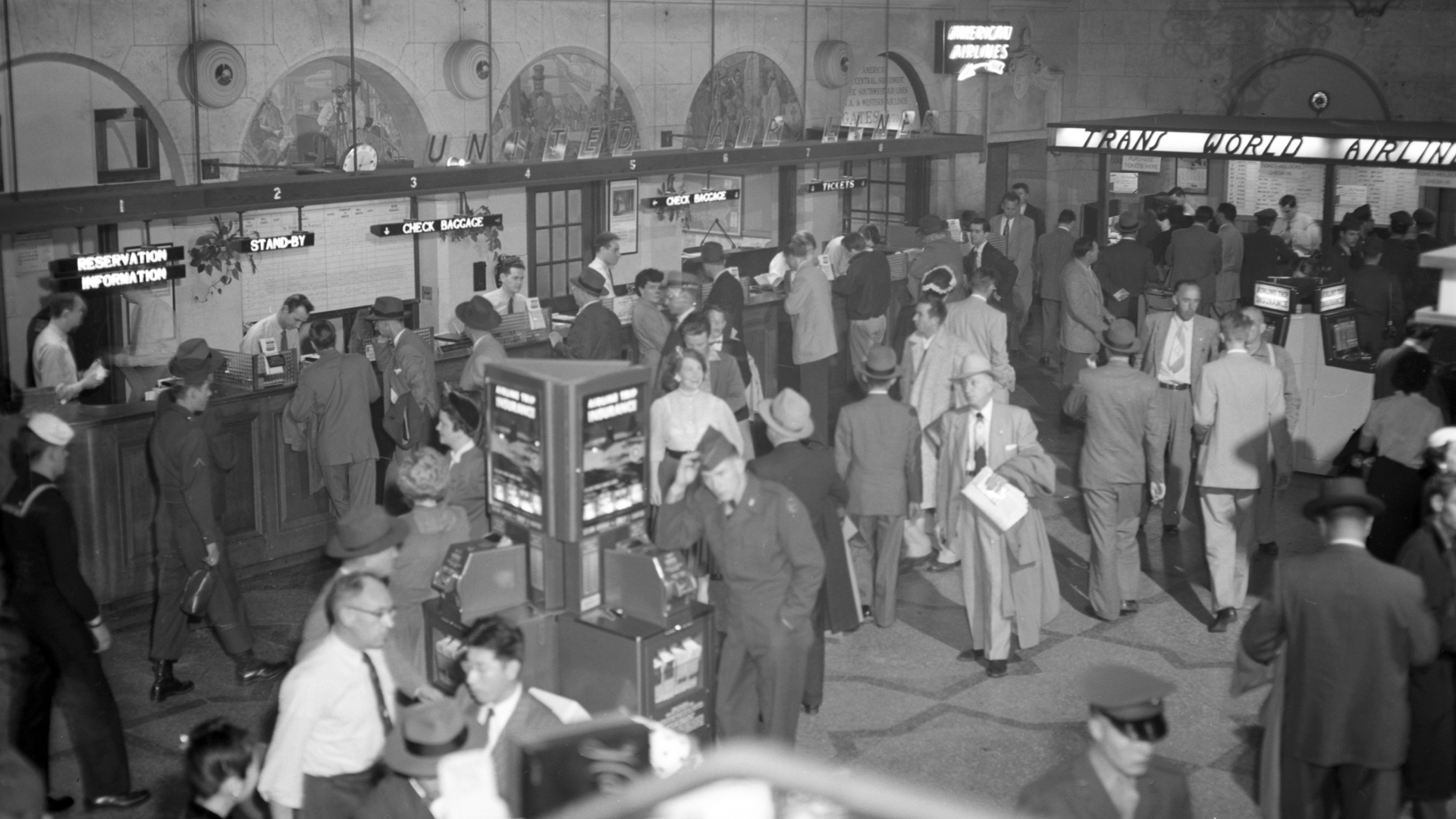
Did you know that in 2015 you could travel from one end of Boarding Area G to the other end of Boarding Area E, post-security? Or that in 2023 you can go all the way to the end of Boarding Area C now? Or that in 2024 you'll be able to do the full loop of all the terminals post-security?
Did you know that if your flight is departing from Boarding Area G and it is delayed by an hour you have time to walk and see a painting by Wayne Thiebaud, a mural by Paul Madonna, works on loan from The Unknown Museum in Mill Valley and a sculpture by Yayoi Kusama?
It's okay if you didn't. Most people don't. This is both the challenge and the opportunity of the SFO Museum. I say it's a challenge because at a very practical level we are competing for people's time and attention. People who are racing to catch a flight, struggling with luggage, trying to keep small children occupied or all the above all surrounded by other people who are all doing the same thing.
Put bluntly people are so busy dealing with the mechanics of travel that they don't even know that they did not notice the Museum even though we are all around them.
The opportunity, for SFO Museum, is that a non-trivial number of those 58 million passengers are going to come back to SFO, at least once. Our opportunity rests in the fact that we are able to say to people: It's okay if you missed something on your first pass through the terminals. It will still be here when you return.
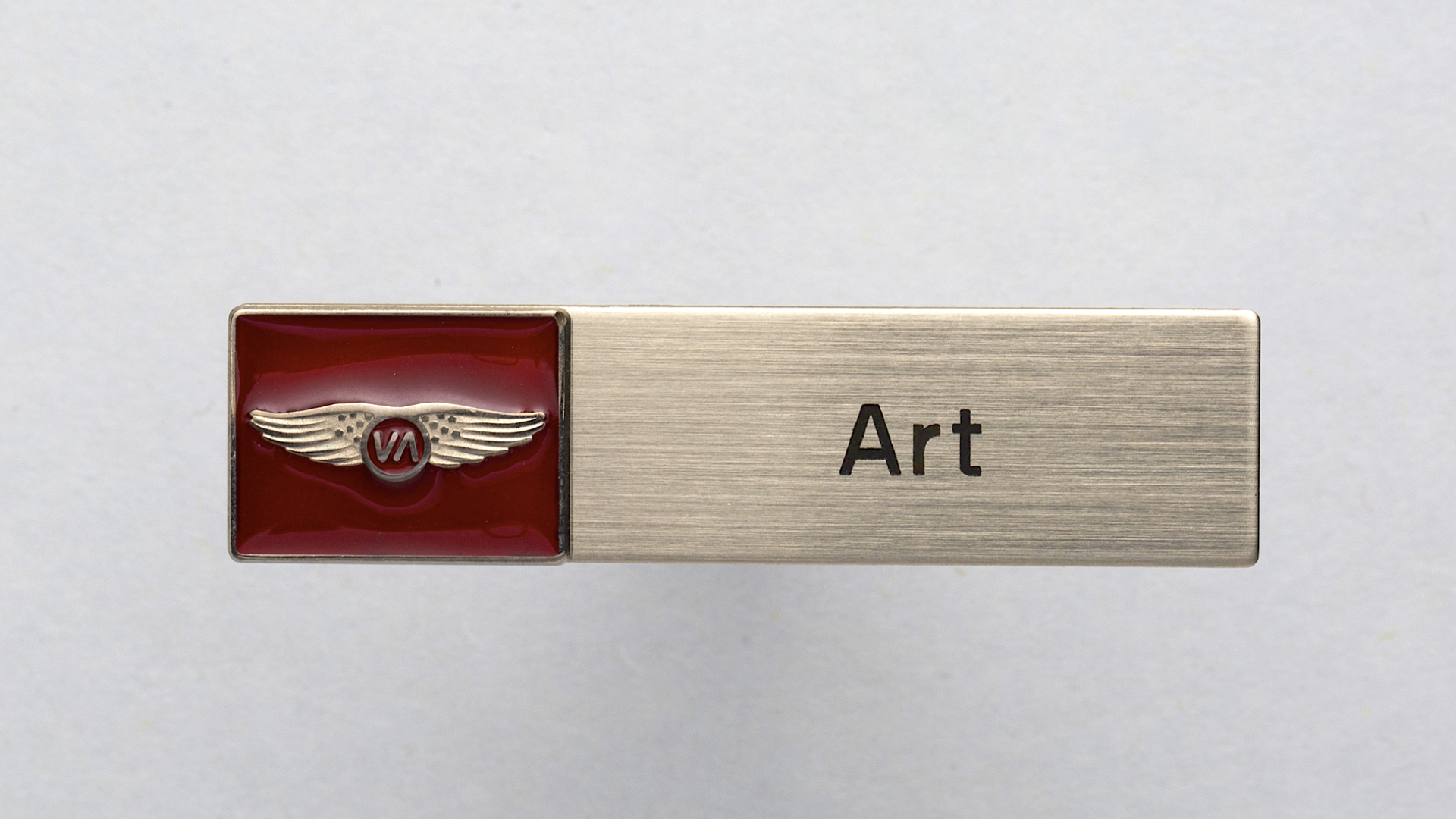
This is a talk about maps because a map is the device we've chosen to use to try and address the problems I've just described. But it's really a talk about what the map makes possible and what those possibilities say about the museum sector in 2023. I am going to show you the work we've done but I am going to show you this work quickly and probably only skim the surface in order to discuss those larger issues, and why they are important, at the end of this talk.
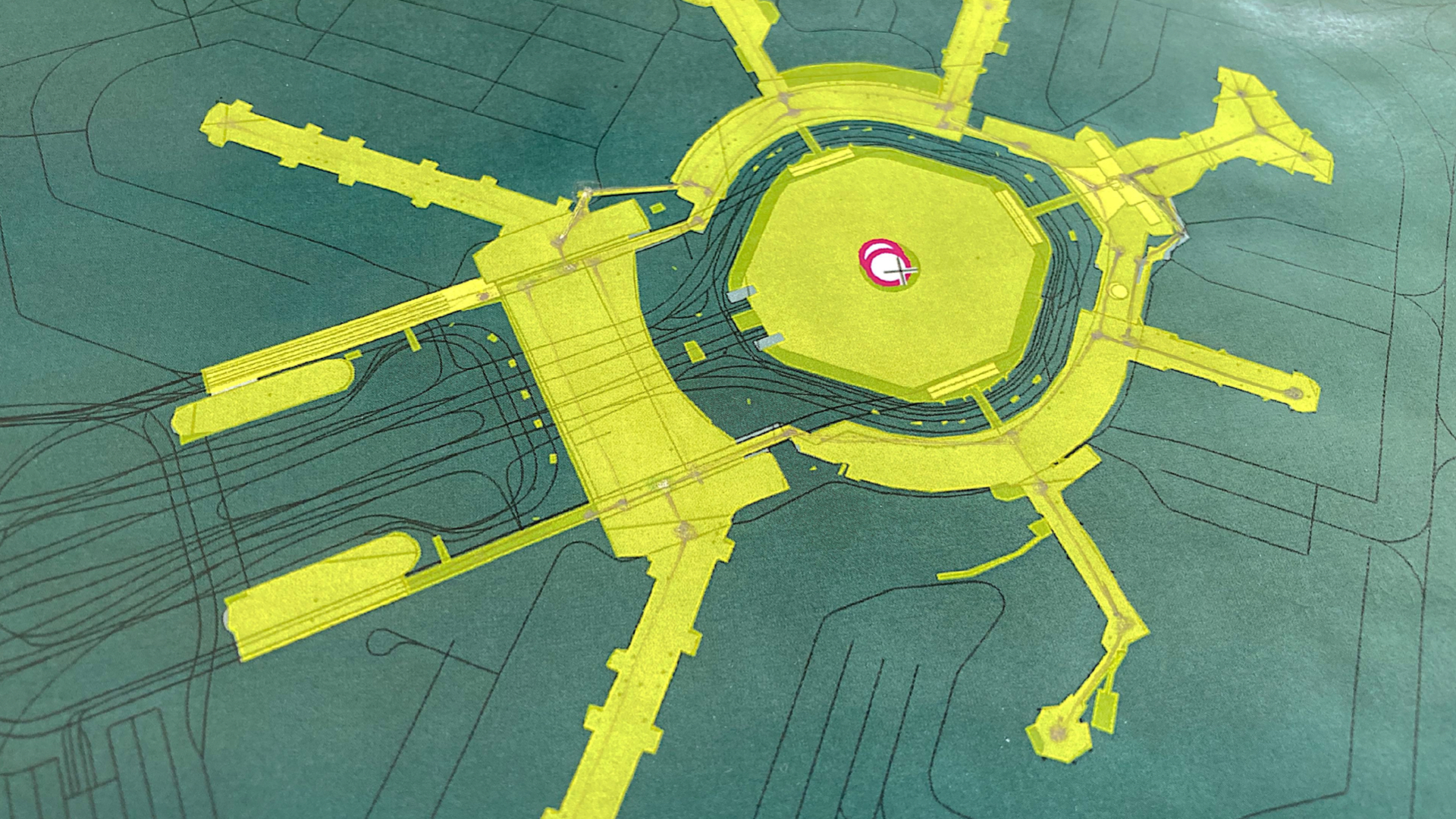
If the goal is to promote discovery of the Museum's programming in the terminals the first questions we need to answer are: Where is a passenger? Where is the thing they are trying get to? How do they travel between those two points?
In a word: Wayfinding, or routing. Which sounds pretty straightforward in principle until you look at the burden and overhead of running routing software, little of which was developed for a complex space like an airport.
It's very easy to get overwhelmed and discouraged by the scale of the problem. But what if it didn't need to be that complicated? More specifically, what if we didn't need a wayfinding system precise enough to be used by automated systems? What if instead we married a very simple wayfinding system with just enough detail to direct a passenger to the general area where a gallery or object is located and then let that same passenger figure it out from there?
This is an early sketch of what I imagined that wayfinding system might look like with a network of about two dozen connected waypoints.
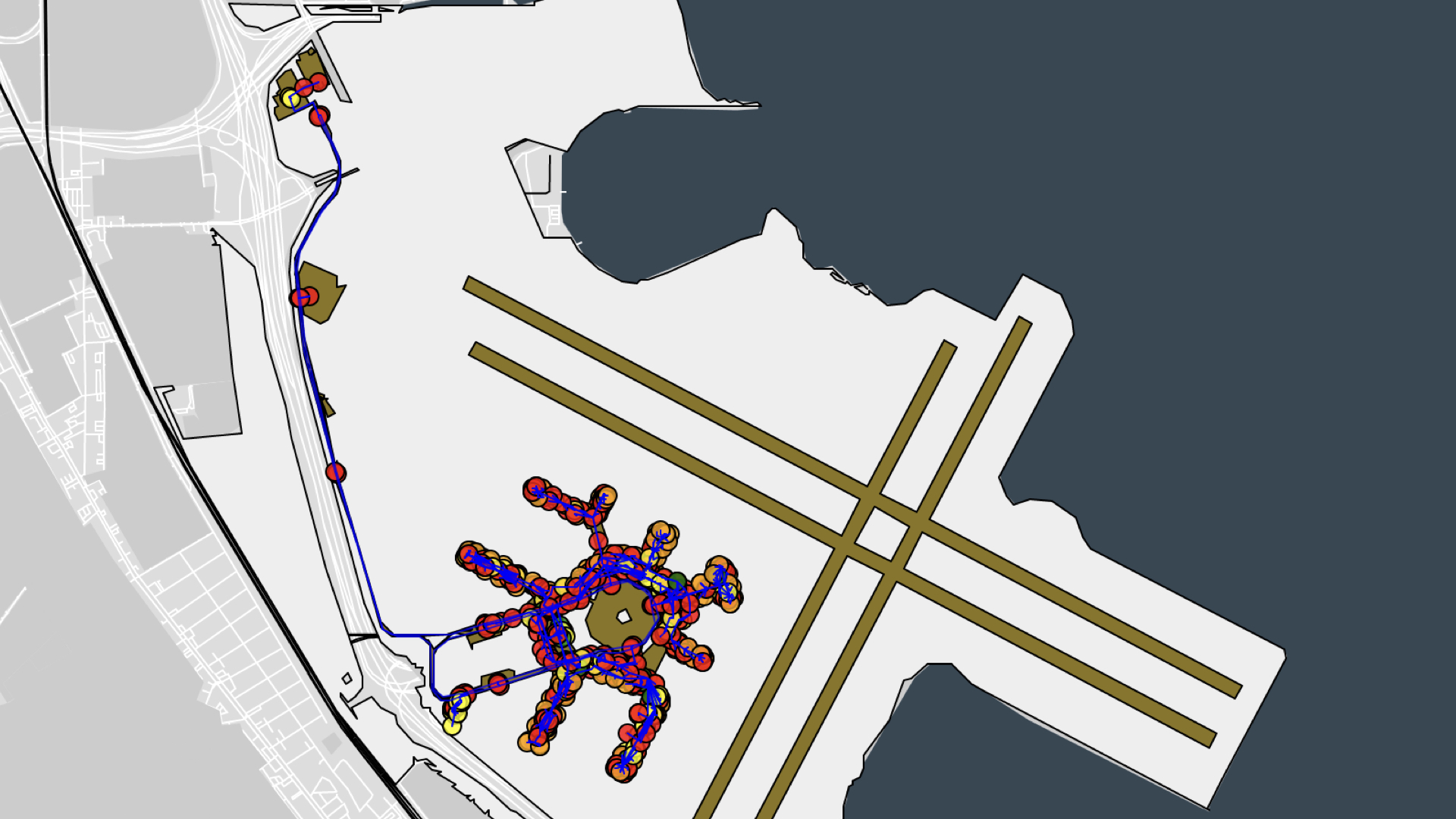
In reality it looks like this. As of today there are about 250 waypoints and another 150 Museum-specific venues and spaces you might be routed to. That's not too bad for something the size of the SFO terminal complex.
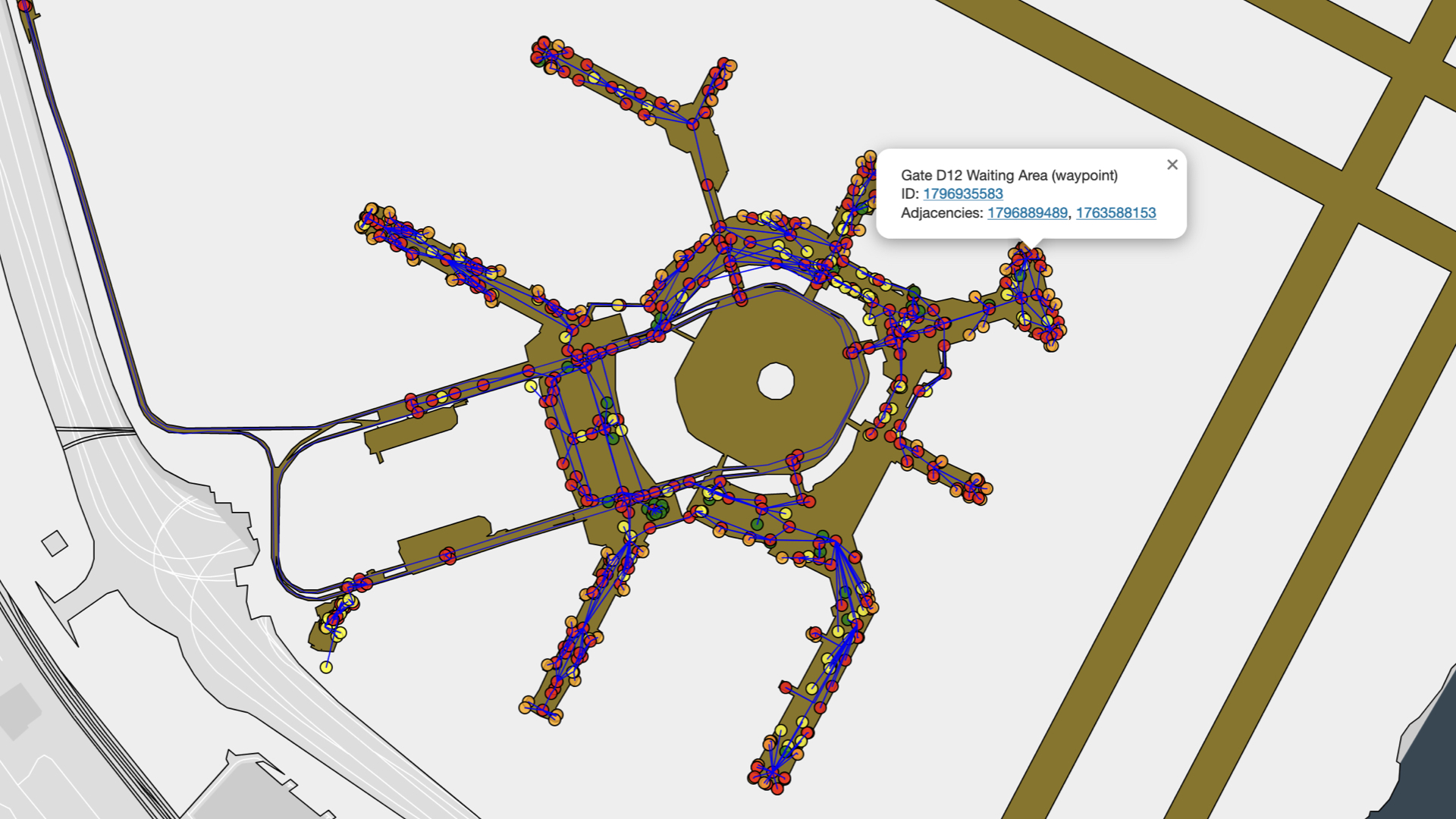
Red dots are waypoints. Orange dots are gates. Green dots are galleries and yellow dots are public art works. It's hard to see in this image but the network also spans multiple levels at the airport.
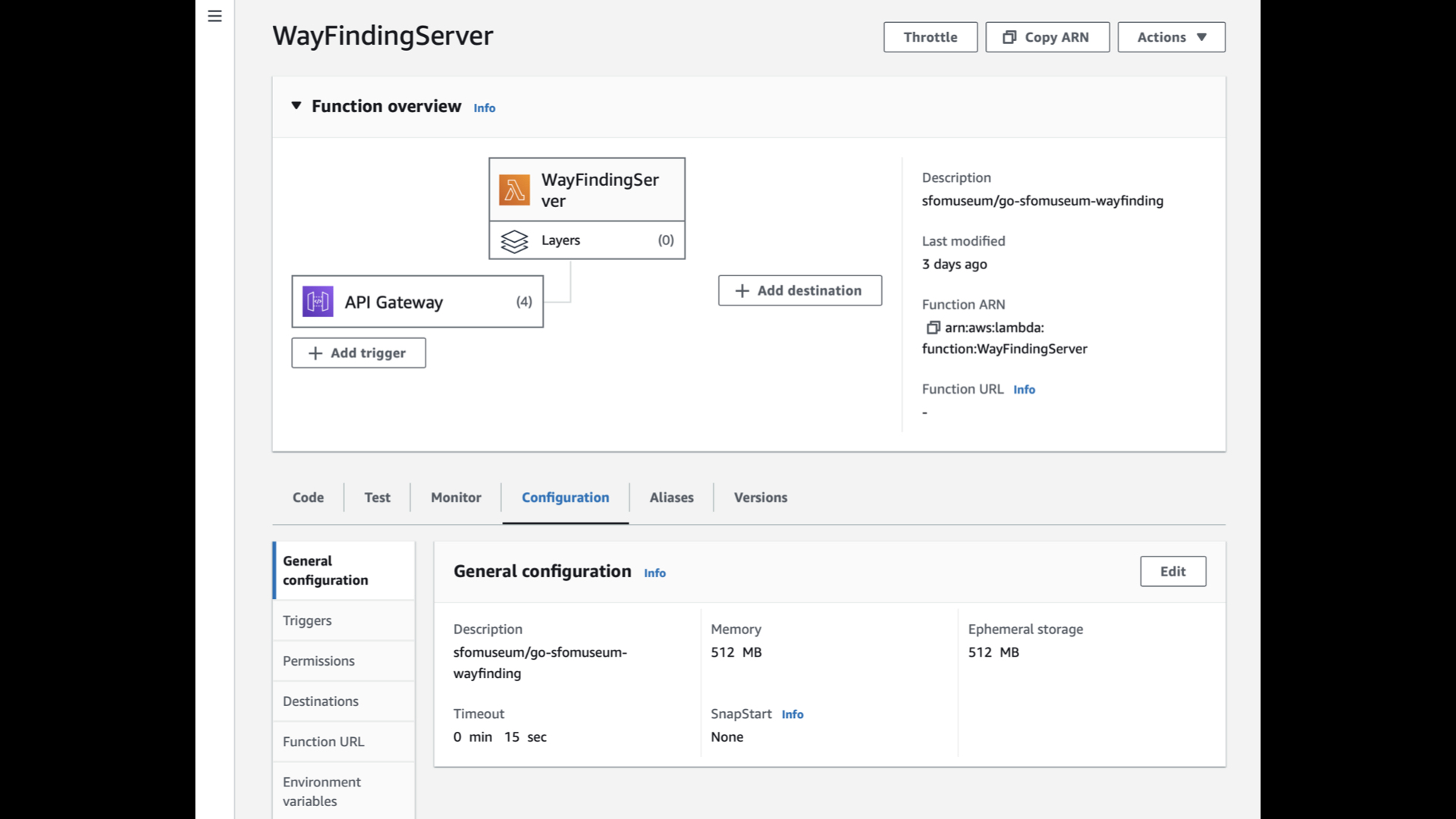
All of that data is bundled in to an Amazon Web Services Lambda function and the actual wayfinding functionality is performed using a directed graph derived from those data, in-memory, at runtime. That's maybe more detail than you wanted but I mention it to point out that this service costs us pennies to run and doesn't require setting up, baby-sitting or paying for a spatial database.
There is obviously a tipping-point in the size of a network where a spatial database becomes necessary but it's important to remember that, in 2023, the distance before which many projects reach that tipping point continues to grow.

Here's what the current iteration of the wayfinding service looks like. Given any two waypoints we can derive the route between them as well as any Museum related content within 50 meters of that route. For example, between the bar at the Grand Hyatt Hotel and Gate B25 there are 16 waypoints and 38 galleries and public art works on display.

After a bit of experimentation we've settled on using modal dialogs for displaying the details for waypoints and museum programming because these translate best to mobile devices and mimic the "sheets" metaphor used in native mobile applications.

Here's a screenshot of the modal dialog used to display Museum-related programming. Did you know that there are Richard Diebenkorn prints hanging in the lobby of the airport hotel? Now you do.

Nearly every gallery in the terminals has been used to show more than one exhibition so we make sure to try and draw people's attention to them.
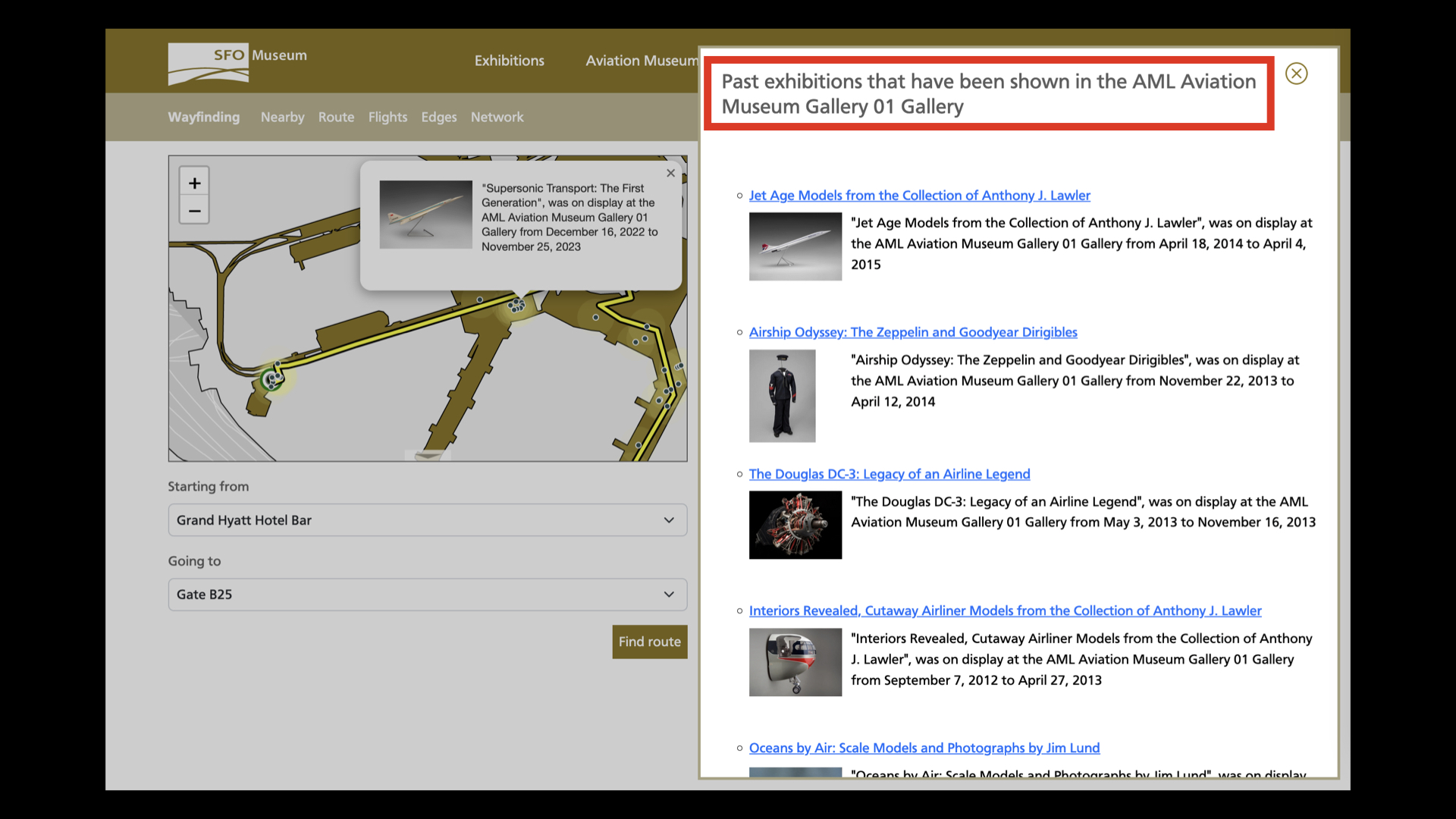
As I mentioned earlier the whole notion of a museum in a airport is still pretty foreign to most people so it's important to show them the depth and the breadth of our work. Very soon we plan to include past galleries, like the one I mentioned at the beginning of this talk, in the wayfinding maps.

Sometimes people don't know where they are in the terminals beyond whatever is written on their boarding pass so we've also made it possible to derive a route from a flight number. We know both the gate and the terminal associated with a flight and its operating airline, respectively, so it's possible to create a wayfinding route through the airport even if a person has never been to SFO before and doesn't know their way around.
A passenger can enter their flight number manually, look it up by gate number or even by scanning the barcode on their boarding pass.
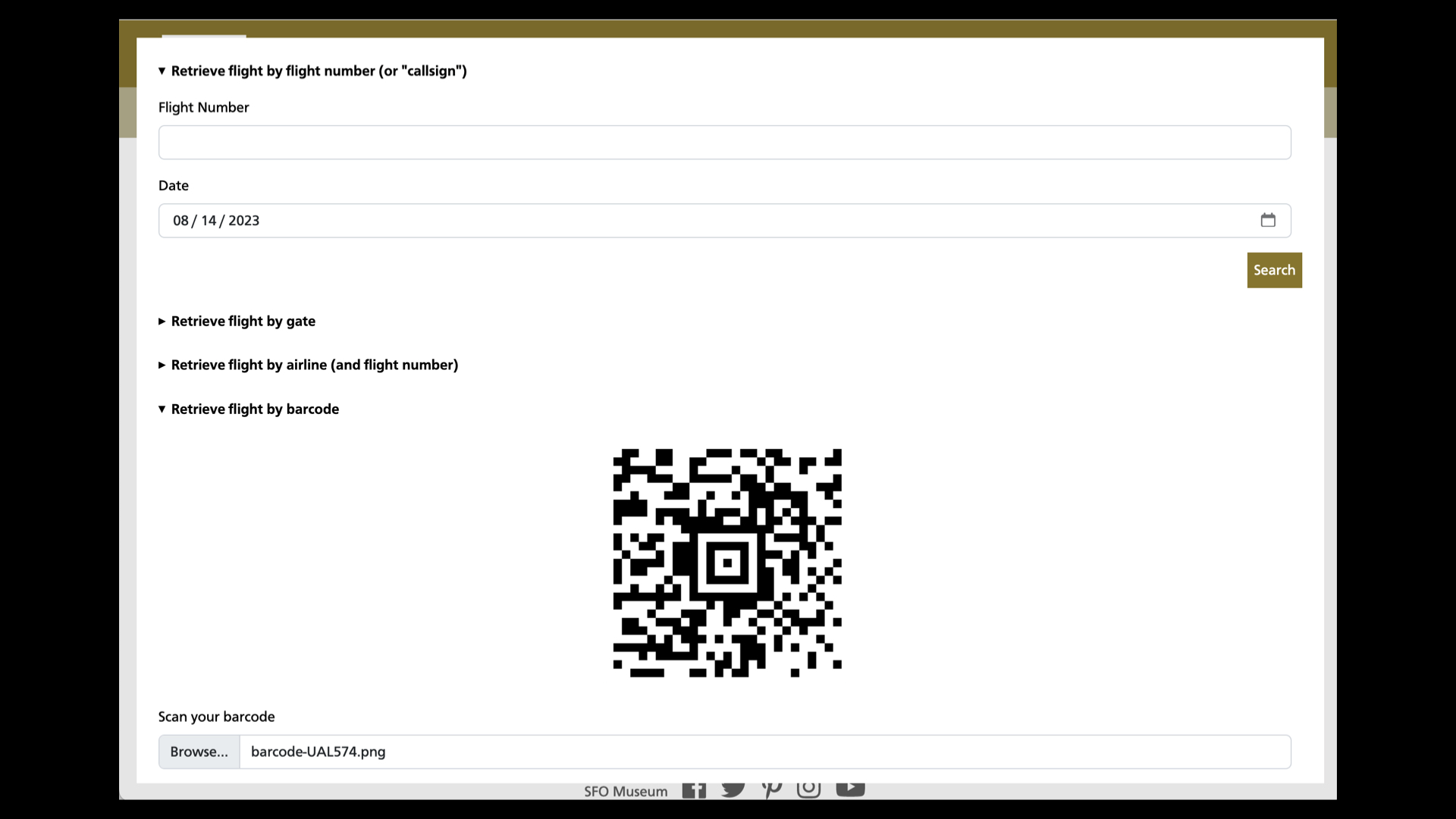
Importantly, the barcode scanner operates entirely on-device and no boarding pass data is sent over the wire to the Museum or the airport or anyone else.
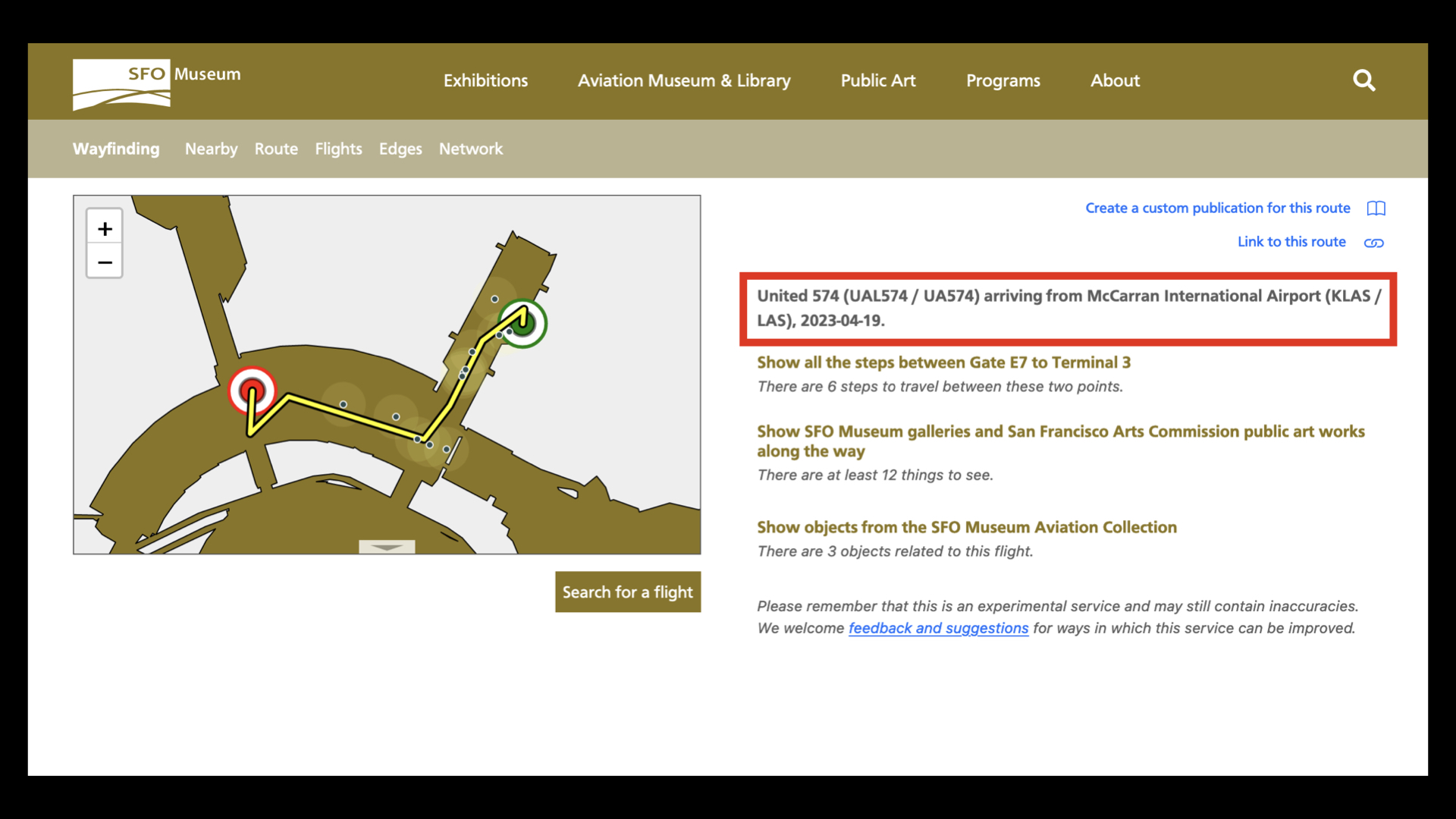
Note that the date for this route is April, 2023. We want to make sure that a person can create a wayfinding route even after they've left the airport or even months after their trip.
As I said earlier, we are operating in an environment where people are busy and distracted and we will not reach them unless we design systems that can accommodate, and adapt to, their reality rather than our hopes and desires.

At the top of every page is a Create a custom publication for this route
link.
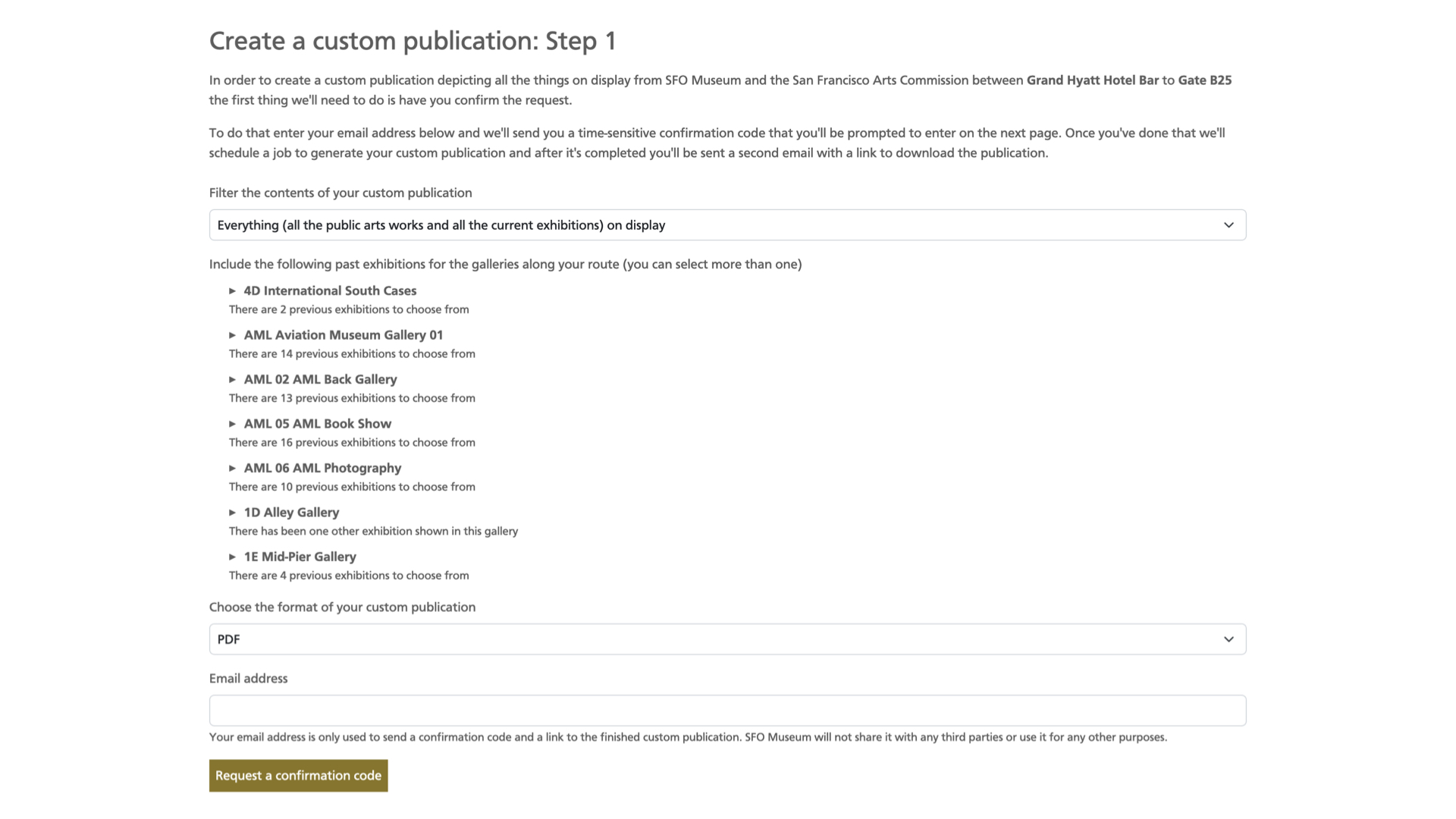
Custom publications are PDF or EPUB "books" that are generated on-demand and contain maps and all the Museum-related programming along a route. You can also choose to include some of, or all, the past exhibitions for galleries along a route.
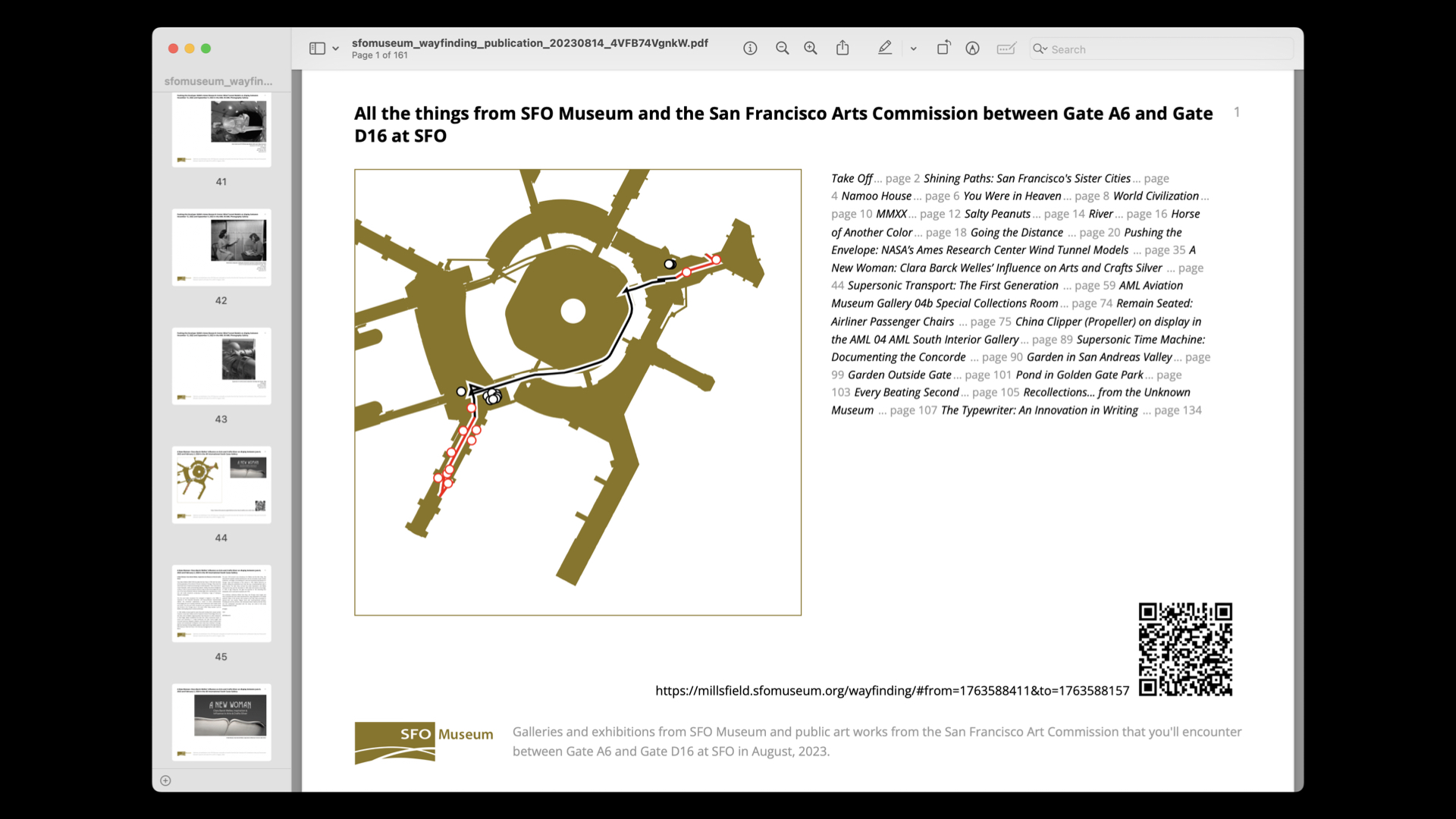
Here's a screenshot of what the title page for a PDF publication looks like, complete with a map and the wayfinding route. These are formatted for standard US letter-sized pages with the idea that they might be printed out for things like a school field trip to the airport or for passengers who know, in advance, that they will have a long layover at SFO.

Here's an example of what an object page for a PDF publications looks like. The Museum produces a number of studio-quality photographs for every exhibition each of which is an opportunity to have something nice enough that you'd want to print it out and pin it to your wall.
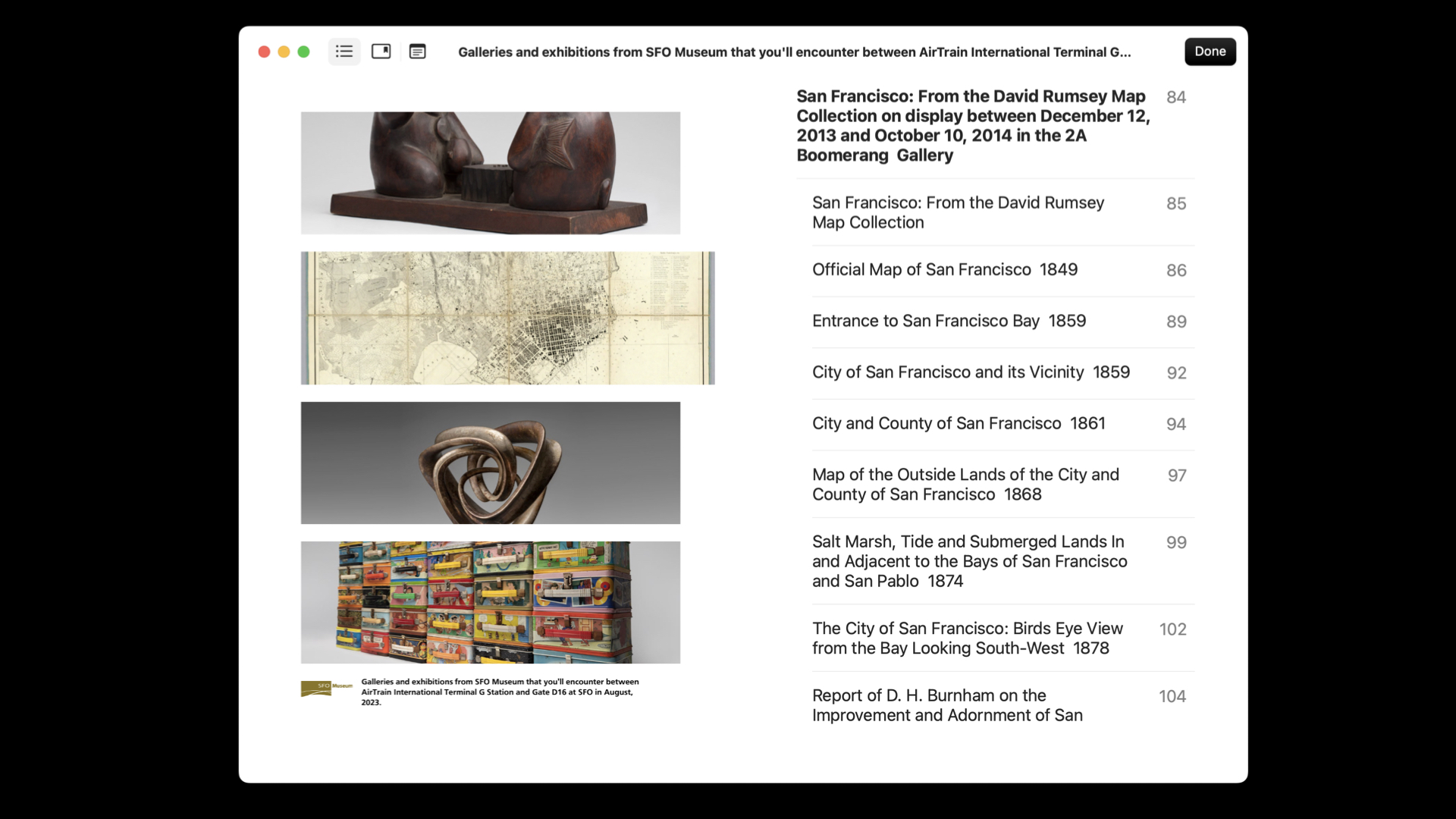
Here is a screenshot of what the table of contents for an EPUB publication looks like. If PDF files are better suited to print hardcopies of a publication then EPUBs are better for smaller screens and the kinds of mobile devices that a person might take on a flight with them. We would like nothing more than to produce an on-demand publication measuring hundreds of pages in length and spanning decades worth of exhibitions that someone will read at 35,000 feet.
For example, in this screenshot you can see the exhibition of maps from the David Rumsey Collection that was on display in the Boomerang Gallery
in Terminal 2 in 2012.
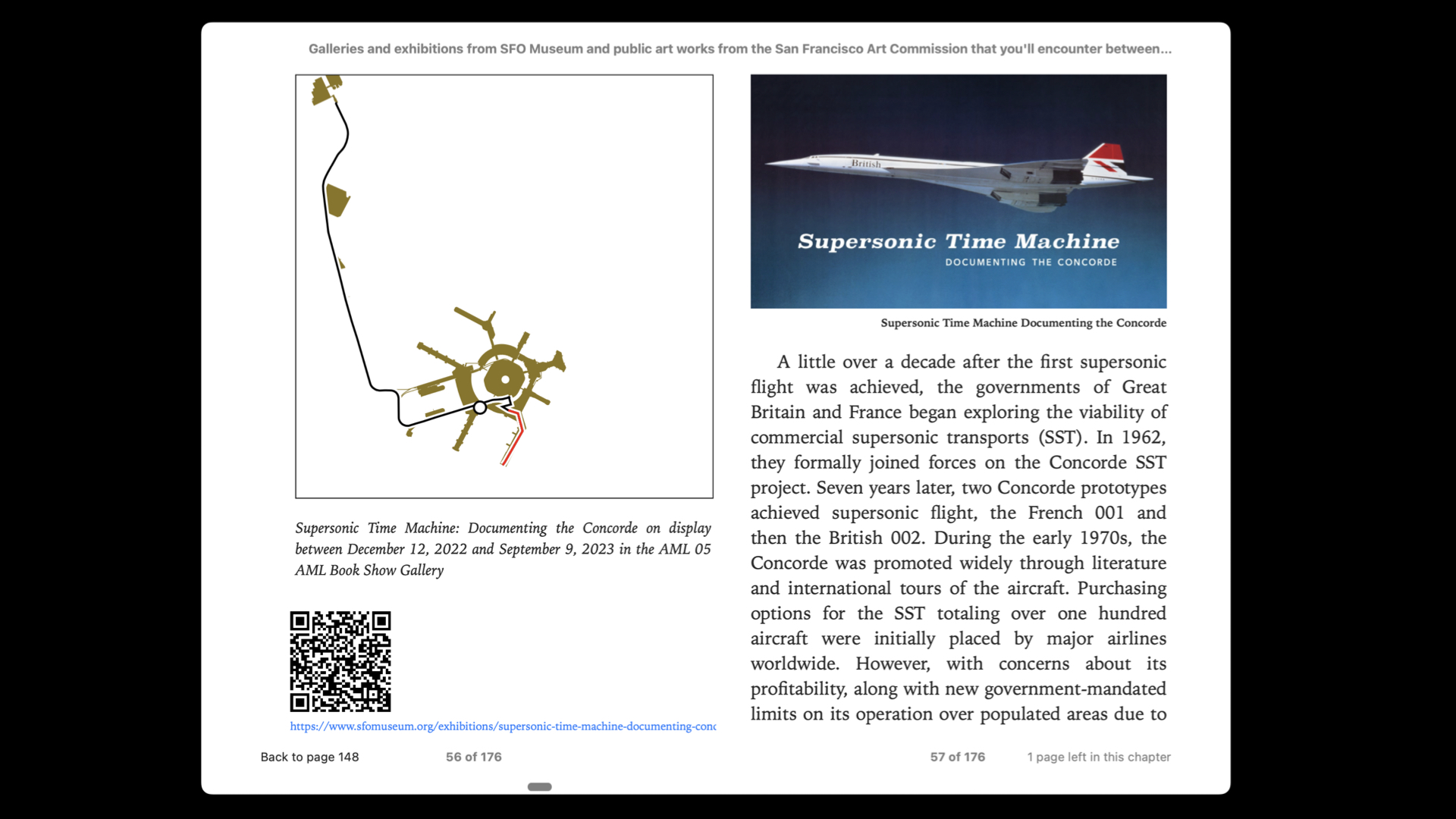
And here is a screenshot of the title page for a given exhibition in an EPUB publication. An online, digital wayfinding system is a useful tool to help situate passengers in the moment. This system and the publications we can derive from it are a useful device to help develop and reenforce a spatial awareness of the totality of the terminal complex and everything it has to offer, notably the museum.
But one of the important threads that runs through all of this work is the idea that visiting the Museum, that fundamentally the Museum itself, extends beyond the building.
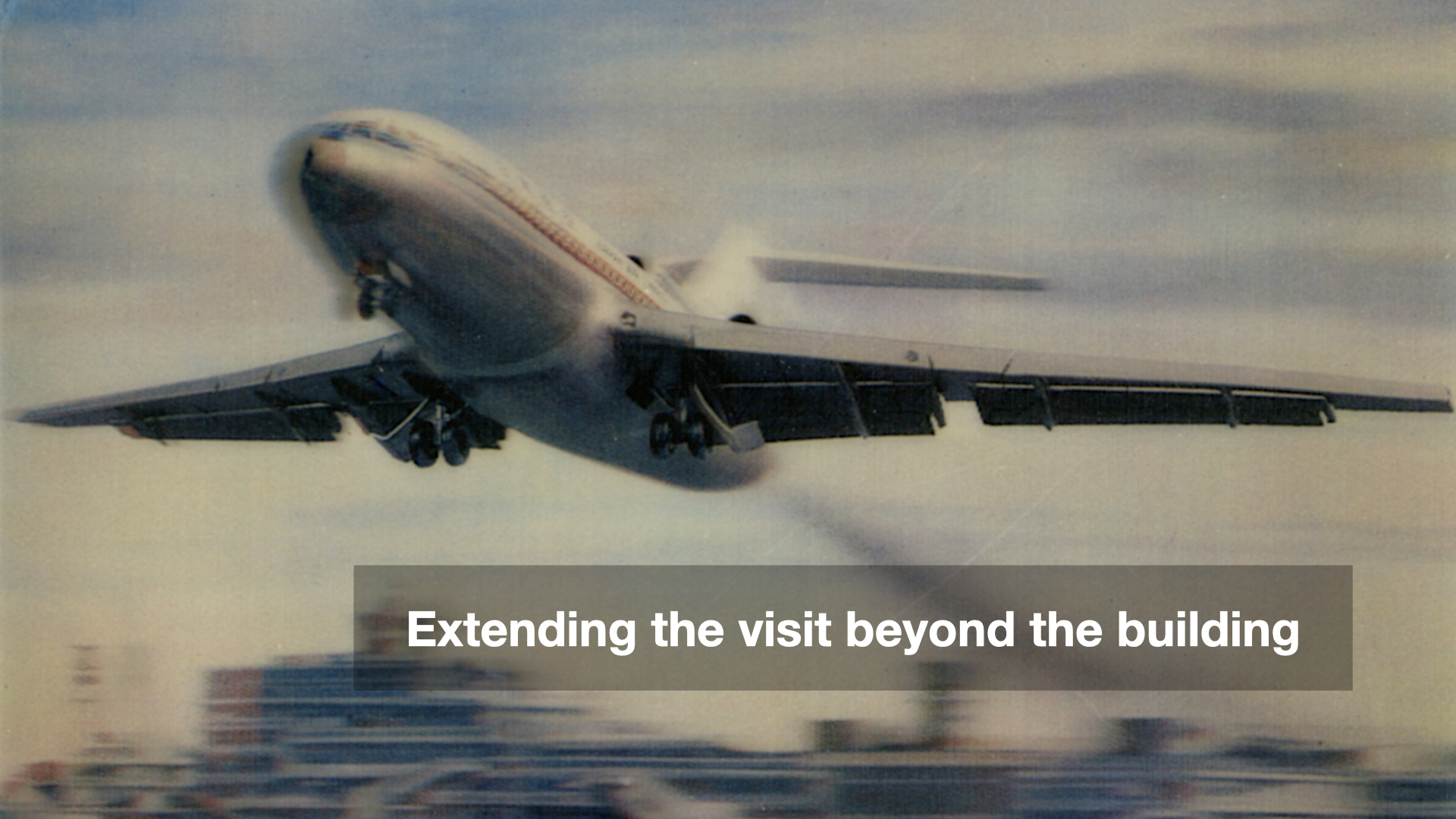
That simple idea is also largely antithetical to the way most museums operate in 2023.
Museums are desperate to get you in the door and to keep you there for as long as they possibly can because, while they will never admit to this, most of them have no expectation you will ever come back. Similarly, an airport has some obvious economic incentives for getting you to arrive earlier than your flight's departure time but sooner or later we know you will leave. In fact, we expect you to leave.
We also know that many, if not most, of those passengers will return to SFO for the second half of their trip if not for an entirely new trip in the future. The great advantage that a museum in an airport has is that we enjoy repeat visitation by default.
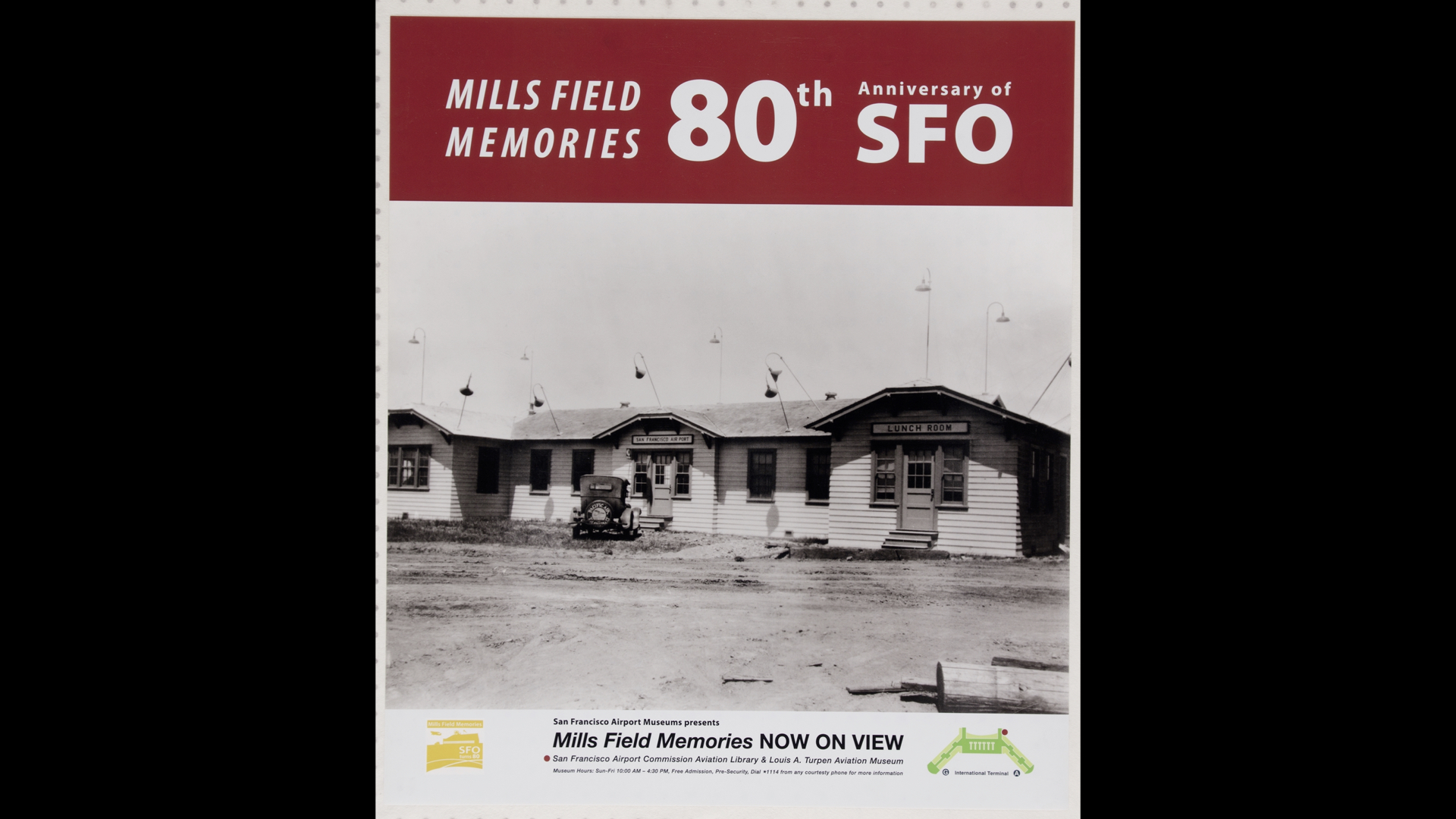
It's not really considered good form, in museum circles, to say this out loud but the reality is that in 2023 few museums enjoy any kind of serious repeat visitation. Most people will ever only visit a given museum once. If they are repeat visitors to a museum fewer of them, still, will be repeat visitors to any given exhibition let alone a single object.
Before COVID-19 this may not have seemed like a problem because the sheer volume of tourists pouring in to museums for selfies or to check things off their bucket lists was sufficiently large that it was easy to ignore the more fundamental questions that repeat visitation, or the lack of it, pose.
Fun fact: The buildings in this photograph are a runway now.
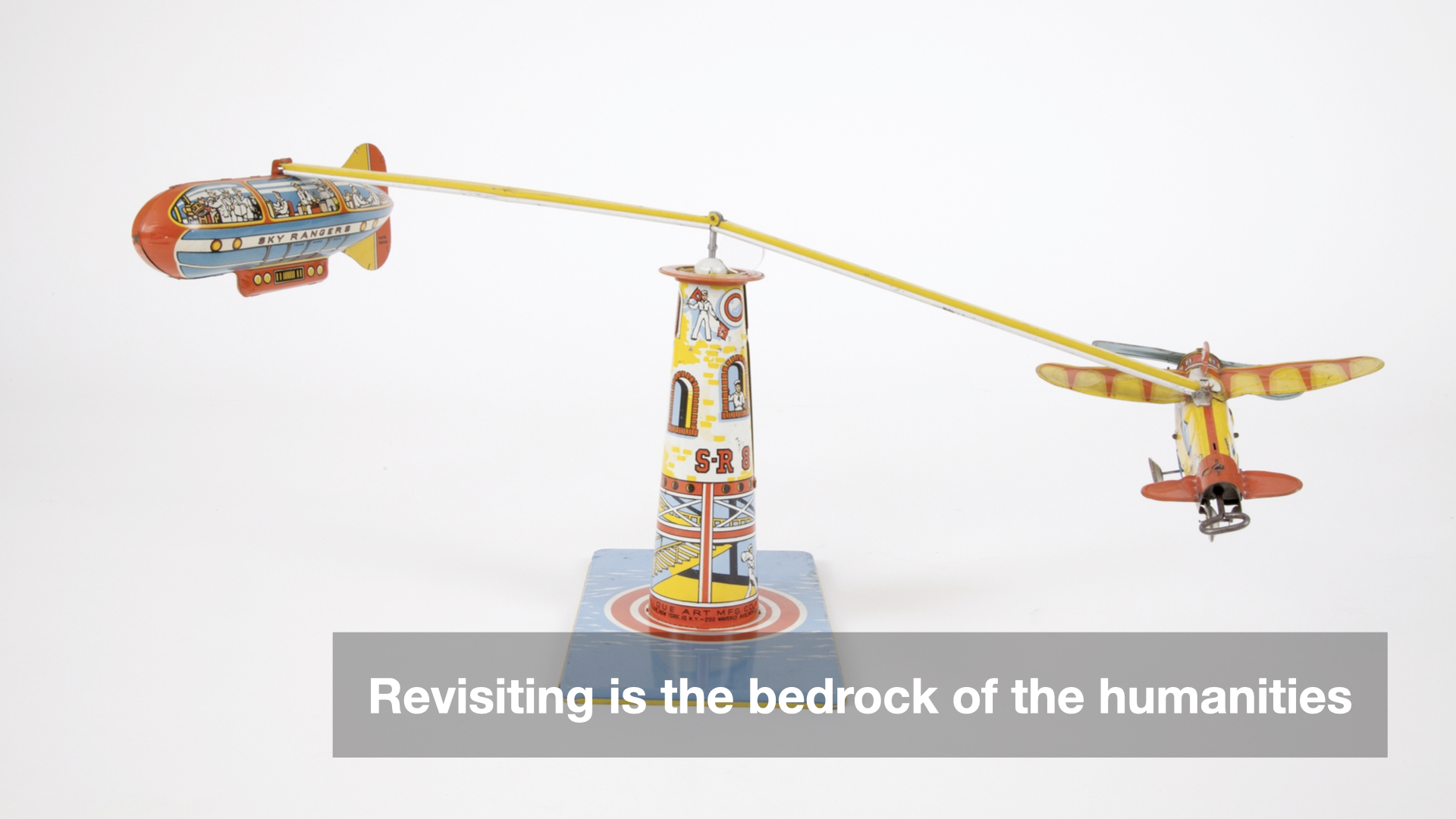
I think these questions are important because I believe the act of revisiting is the bedrock of cultural heritage and the humanities.
I believe that the thing which distinguishes entertainment from culture is the act of revisiting. There is a time and a place for both things and, importantly, works which begin life as entertainment
routinely transition to become culture
. But it is precisely in the act of revisiting these works of entertainment, though, that their transition to culture
occurs.
It is in the turning over of a work, of debating it and viewing it from different vantage points, again and again and again, that something becomes more meaningful than simple escapism or the stimulating of nerve-endings.
I want to argue that contemporary museums have evolved to make revisiting the exhibitions they show and the collections they shepherd as difficult and prohibitive as possible. This happens in a number of ways but chief among them are the prohibitive costs of entry. The economics of running a museum in the early 21st century are a hot mess, for a lot of complicated reasons, but all visitors know is that it costs them upwards of 30$ each time they want to enter a museum.
That's a pretty powerful disincentive for most people and one that is compounded further by the inability or the unwillingness of museums to meaningfully embrace the internet as a tool to make any kind of post-visit (or even pre-visit) interactions possible.
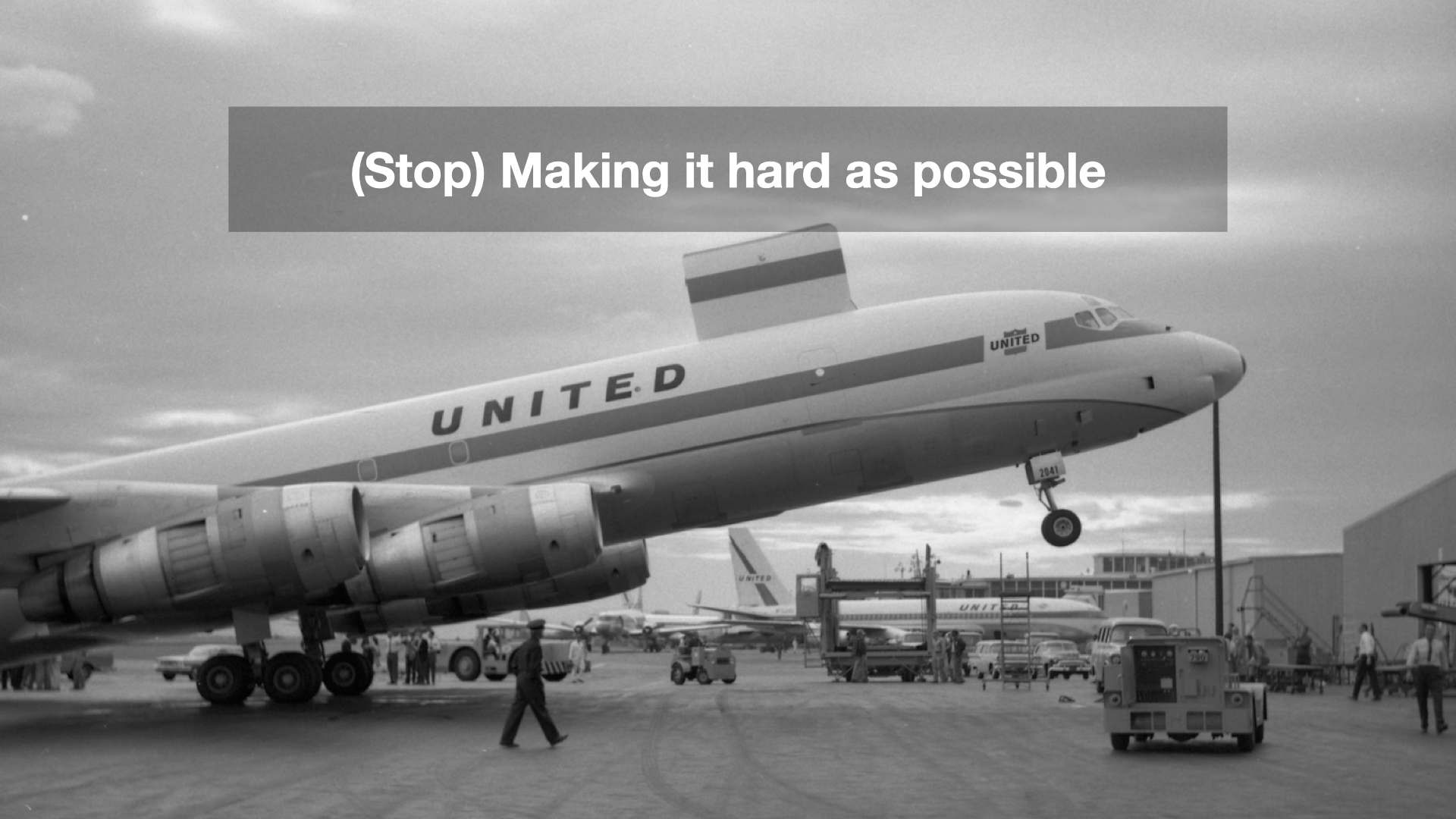
If a museum's purpose is not to foster revisiting, though, then how is it different from any other manufactured distraction available to the public today?
If museums, by their actions, actively work against the very idea of revisiting as anything but a commercial transaction why then should they enjoy a position of prestige relative to video games, for example, or other media companies? Why should anyone care about all these "weird, old things" given all the other options?
I want to be clear about something: I do not think that SFO Museum's Wayfinding system, alone, will solve these problems. The museum sector, as a whole, has painted itself in to a pretty deep corner and I am not sure it's accepted that reality yet let alone thought about ways to address the issues it faces. This is the burden of museum professionals working in 2023.
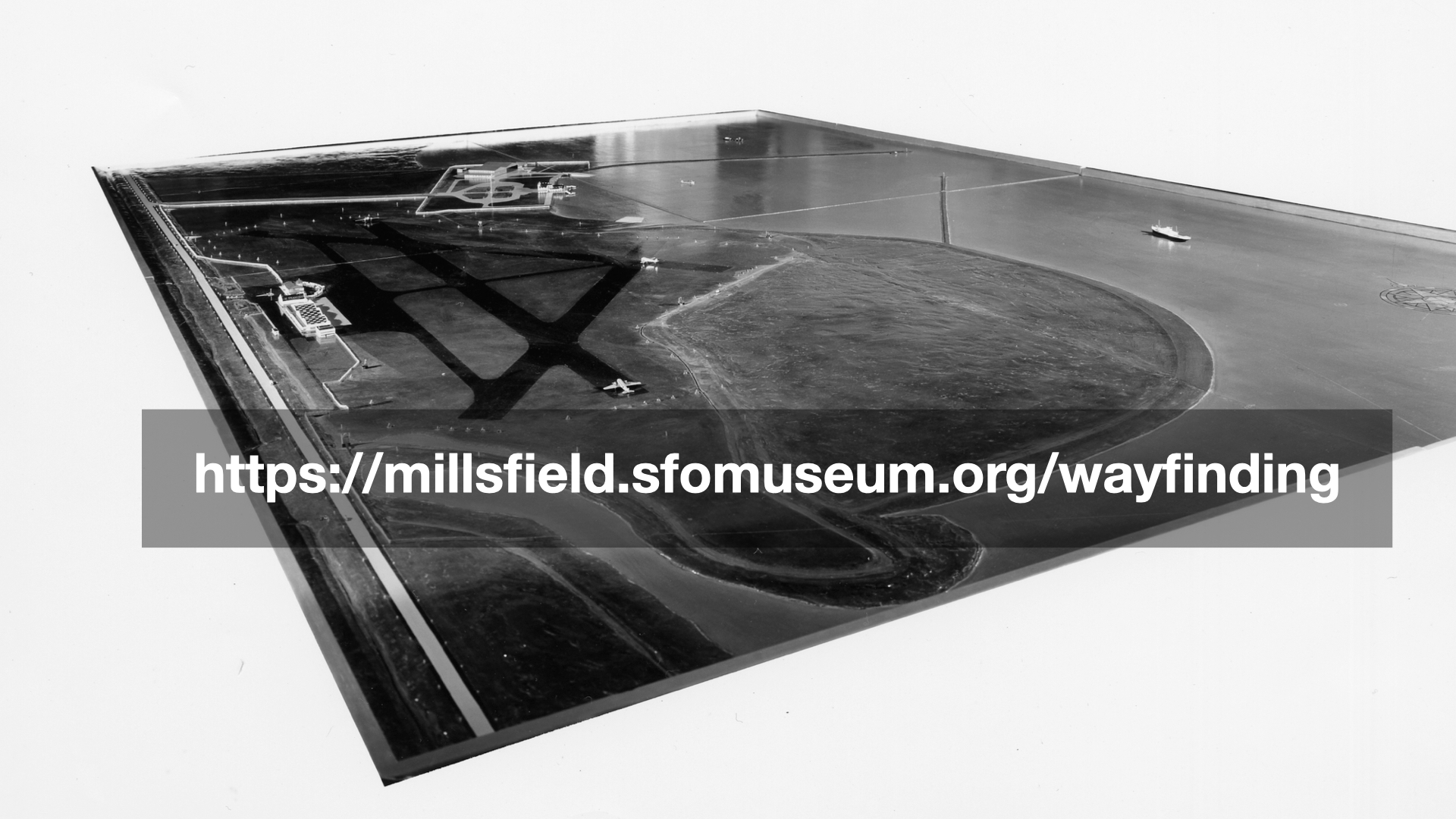
The SFO Museum Wayfinding system is one attempt to build a practical solution to a specific problem – Where is something from the Museum at the airport relative to a passenger and how do we direct that passenger there? – and to do so within the operational and financial constraints of a museum.
But it is also an attempt to make manifest, in both theory and practice, the idea that a museum at an airport can be a place of revisiting. That the value of the Wayne Thiebaud painting in Terminal 3, for example, comes from being able to spend 10 minutes with it before your flight every time you come to the airport. And that the museum will follow you out of the airport – through the use of wayfinding tools and custom publications and other devices – as a way to ackowledge people's busy lives and as a way to encourage them to revisit something they might have missed the last time they were at SFO.
Thank you.
This blog post is full of links.
#wayfinding